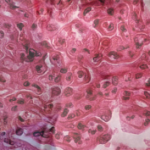These data suggest that both CY and AZA are effective for treating LN but that CY is superior, especially for patients with aggressive disease. Another reading of this trial is that by employing more potent and thus potentially more toxic agents, some patients may be overtreated, whereas by using less potent agents some patients may be undertreated. This observation reinforces the need for stratification of patients according to disease severity.
Cyclophosphamide
Randomized controlled trials (RCTs) from the NIH, with long-term (more than 10 years, sometimes as long as 20 years) follow-up in patients with predominantly proliferative LN, showed that CY regimens (daily oral or monthly IV pulses) in combination with glucocorticoids are effective in halting progression to ESRD. From these studies, protocols based on the use of high-dose IV-CY (0.75–1.0 g/m² per month) emerged as the gold standard for proliferative LN or membranous nephropathy with nephrotic-range proteinuria. The combination of pulse IV-MP and pulse IV-CY increased efficacy without added toxicity.5 In our studies, longer treatment protocols (seven monthly pulses followed by an additional eight every three months, for a total of 15 pulses) decreased the risk of flare as compared with shorter courses (seven monthly pulses), albeit at a higher risk for sustained amenorrhea (a three-fold increase in risk in women older than 26 years treated with a longer course of CY).
Subsequent efforts aimed to reduce the cumulative dose of cyclophosphamide by limiting its use to only induction regimen and by using lower doses. Trials led by Frédéric Houssiau, MD, PhD, in Belgium, involving exclusively European patients, have demonstrated the long-term efficacy of lower doses/shorter courses of IV-CY followed by the use of AZA for maintenance.6,7 As a result, the standard of care for most patients with proliferative LN has shifted. Thus, CY is being used currently only as induction therapy, with several European centers using the low-dose IV-CY and most North American centers using the NIH high-dose regimen. The difference in the cumulative dose of CY used in these protocols for an average person (body surface approximately 1.7 m2) is nearly four-fold (3 g in the low dose versus approximately 12 g in the high dose).
It is worth emphasizing that neither low-dose IV-CY nor MMF has been tried for the most severe cases of lupus nephritis. For patients with severe proliferative LN (defined as rapidly progressive nephritis or patients with impaired renal function or adverse histologic features such as fibrinoid necrosis, crescents, or significant chronicity) connoting a worse outcome, there is only a single RCT, published in 1992 in The Lancet and written by us, where high-dose pulse IV-CY was used.8 In this study and after five years, over 80% of patients treated with pulse IV-CY maintained renal function compared with only 50% of patients treated with pulses of IV-MP. A long-term (up to 15 years) follow-up of these patients confirmed the durability of the IV-CY effect.
Fallout of the NIH CY Trials
Based on its superior efficacy, pulse CY became the treatment of choice for severe lupus during the late 80s and 90s. Passionate debates at international meetings and editorials in leading journals pointed out the small number of patients participating in the NIH trials and warned against adopting the NIH regimen for all patients. In those debates, reasoning and moderation often seemed lost, with some people arguing that cyclophosphamide should never be used, while others failed to differentiate between severe and milder cases of LN and advocating universal usage of the drug. What some people failed to recognize is that not all patients treated with corticosteroids or AZA necessarily had a bad outcome and that differences among the various treatment arms did not emerge until after five years. Thus, although CY may be more effective than AZA or corticosteroids, some patients may be overtreated. On the other hand, the majority of patients would be undertreated if CY were not used.
